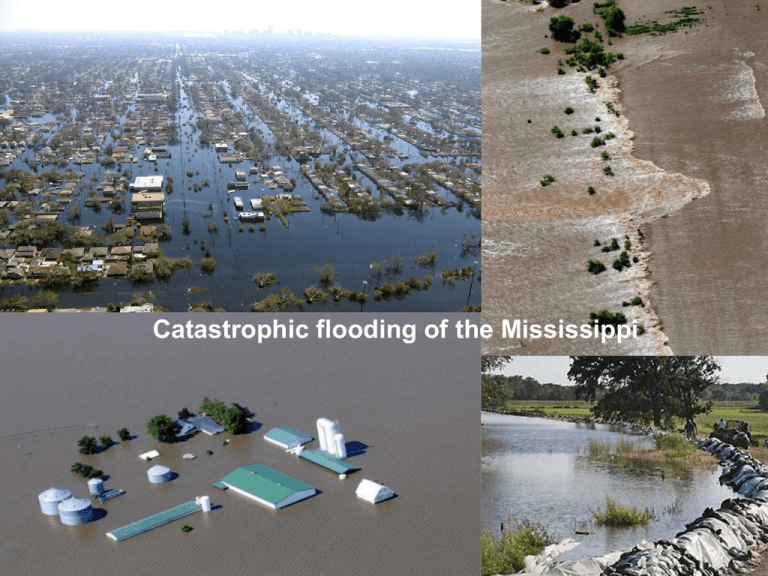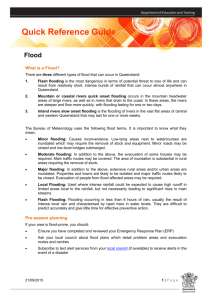Catastrophic flooding of the Mississippi Rivers and floodplains
advertisement

Catastrophic flooding of the Mississippi Rivers and floodplains Flooding Cedar Rapids, Iowa (2008) The Amazon basin floods every year, an integral part of this rainforest ecosystem. Opposite the city of Manaus, the Amazon and Negro Rivers flow together. The Amazon is muddy brown in contrast to the clearer, dark waters of the Negro. (Top) NASA image (June 29 2009). Floods on the Negro receded; flooding still evident along the Amazon (image blurred by clouds). (Bottom) Amazon and Negro rivers (June 7, 2004), a year when seasonal flooding was not extreme. Tiny white flecks along the river are buildings. The rainforest that lines the river is dark green, while cleared land is lighter in color. It is quite likely that the flood actually extended across the entire land between the two rivers, but the dense forest canopy rises above the water, hiding the floods beneath. Rivers are dynamic features in the landscape! The wooden steamer, the SS Sultana, was a Mississippi paddlewheeler built in 1863 and destroyed in an explosion in 1865 resulting in the greatest maritime disaster in U.S. history. Some 1,800 passengers were killed when one of the ship’s boilers exploded near Memphis, Tennessee. The Sultana on fire, from Harpers Weekly The ship was originally built for the lower Mississippi cotton trade and had a legal capacity of 376 passengers. When it sank, it had more than 2,000 people on board, mostly Union prisoners of war released from their Confederate prison camps and on their way home (many were from Ohio). In 1982, an expedition uncovered the wreckage of the Sultana. Blackened wooden deck planks and timbers were found about 32 feet under a soybean field on the Arkansas side, about four miles from Memphis. The Mississippi River has changed course several times since the disaster. The main channel now flows about two miles east of its 1865 position. Restoration of streams also involves the floodplain; not only because the river flows sideways but also because the channel naturally migrates and creates storage. Where and when possible, “let the river be a river”. Bottom line • Although there are general paradigms, no two rivers and streams are alike. – Even within one river system, habitat is extremely diverse and dynamic. • Rivers flow from upstream to downstream, but they also flow sideways. • The watershed is critical scale for management and research. Both require a multidisciplinary approach. • The majority of rivers and streams in the developed world have been ditched, diked, dredged and/or dammed. • River floodplains are important because they – cover large areas of earth’s surface, – contain highly adapted fauna and flora, – interact closely with adjacent ecosystems (and the atmosphere), – are under rising pressure from development, and – provide “free” ecosystem services. Seasonally inundated bottomland forest communities along a stretch of the Mississippi. Seasonally inundated floodplain forest along Amazon River. Note white and black water stretches (True-color Terra MODIS image; September 8, 2002). Sampling equipment Surber sampler Seine Flow measurement Kick seine Fig 4-2. Moss Stream order nomenclature Stream order nomenclature (see also Fig. 11.7) River Continuum Concept (Vannote et al. 1980) Hypothesis: The biology of a stream is adapted to gradients in physical (geomorphological) features of the stream Fig 4-11. Moss Osborne, 2000 Hypothesis: The biology of a stream is adapted to gradients in physical (geomorphological) features of the stream River Continuum Concept. Fig 2 Vannote et al. 1980 The flood pulse concept (Junk 1989): The flood pulse is the driving variable of the river-floodplain system. Biotic and abiotic processes in the Aquatic-Terrestrial Transition Zone (ATTZ) regulate species composition, food webs and nutrient dynamics. Várzea forest during dry phase Inundated Várzea forest The flood pulse concept (Junk 1989) states that the flood pulse is the driving variable of the river-floodplain system and that biotic and abiotic processes in the AquaticTerrestrial Transition Zone (ATTZ) are primary regulators of species composition, food webs and nutrient dynamics. Echinochloa polystachya (creeping river grass) Very fast growth rates. Annual net production among highest for all plants. Important food source for grazers such as capybaras, manatees, turtles, herbivorous fish. Echinochloa polystachya. Well adapted to unstable environment. Stands of this grass are replaced by forests if flooding becomes less and by aquatic macrophytes if aquatic phase dominates . • Organisms must survive during both wet and dry phases lots of survival strategies (incl. migration, dormancy, seed and rhizome production, etc.) • High mortality (aquaticterrestrial pulse is high stress) strong pressure on organisms to have short life cycles, rapid reproduction, high reproductive rates high productivity. • Nutrient release from sediments under anoxic conditions during aquatic phase. • Anoxia in water and sediment during flood periods CH4 (and H2S) production pulsed floodplains sources of greenhouse gases. The impact of the flood pulse on the fishes in the floodplains of large Amazonian rivers (Junk 1996) Ferreira C S et al. AoB Plants 2010;2010











